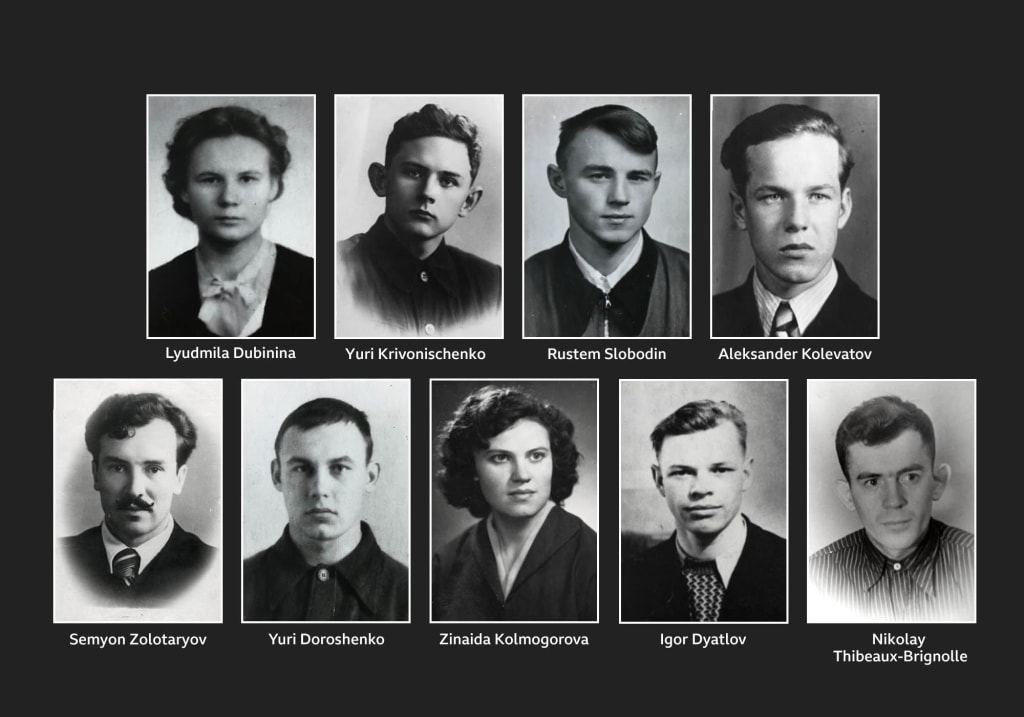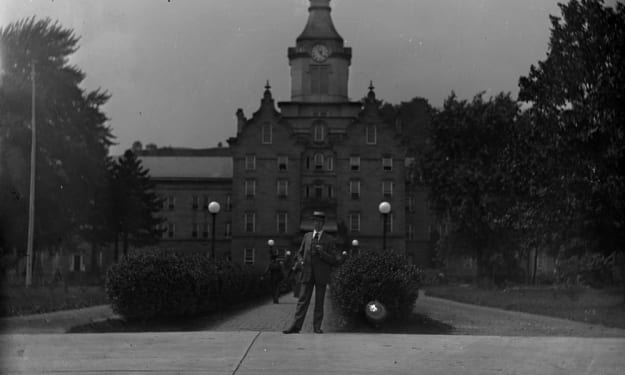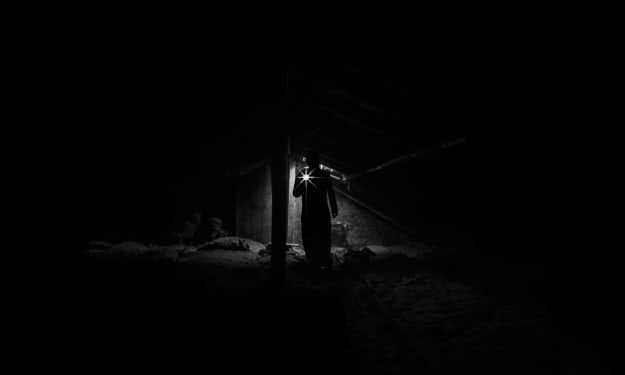Unearthly Terror in the Ural Mountains
The Perplexing Case of the Dyatlov Pass Incident

In the desolate and unforgiving expanse of Russia's Ural Mountains, where the biting cold can freeze the marrow in your bones, lies a tale that has haunted the minds of adventurers, investigators, and conspiracy theorists for over six decades. It's a chilling narrative of a group of nine hikers, their daring expedition on the Otorten Mountain in February 1959, and the nightmarish sequence of events that unfolded. This expedition, led by the intrepid Igor Dyatlov, should have been just another chapter in their adventure-filled lives. However, what transpired on that fateful journey turned into one of the most perplexing, terrifying, and enduring mysteries of the 20th century - the Dyatlov Pass Incident.
The Trail to the Unknown
In the bitter cold of a Russian winter, where temperatures can plummet to -30 degrees Celsius (-20 degrees Fahrenheit) and beyond, a group of nine hikers set out on an expedition that would become an enduring enigma. These were no ordinary hikers; they were experienced mountaineers and students, led by the charismatic and seasoned Igor Dyatlov. Their destination was the remote and treacherous Otorten Mountain in the Ural Mountains, a region known for its unforgiving terrain and harsh climate.
The year was 1959, a time when the Soviet Union was at the height of its power, and a group of young adventures seeking the thrill of the wildreness seemed to embody the spirit of their era. Armed with the best gear available for the time and a meticulously planned itinerary, they embarked on a journey that would take them into the heart of the Ural Mountains, a place where few had dared to tread.
The Ascent Begins
The expedition commenced with high hopes and enthusiasm. The hikers, most of them in their early twenties, were well-prepared for the challenges that lay ahead. They documented their journey through photographs and diaries, capturing the excitement of the adventure and the camaraderie of the group. The early days of the expedition were marked by the triumph of the human spirit against the harsh elements, a testament to their determination and outdoor skills.
As they made their way through the unforgiving wilderness, the hikers faced the trails of extreme cold, heavy snowfall, and the physical demands of the rugged terrain. Yet, these challenges were exactly what they had trained for, and their progress remained on schedule.
The Eerie Campsite
The group's journey reached a chilling turning point on the night of February 1, 1959, when they established their final campsite on the eastern slope of Kholat Syakhi, a mountain that would later become infamous as "Dead Mountain." It was here that their expedition took a terrifying and inexplicable turn.
Their tent, a vital refuge against the biting cold, was found in a state of bizarre disarray. It had been cut open from the inside, as if the hikers had urgently fled the safety of their shelter. Outside the tent, in the midst of the frigid night, lay the imprints of their barefoot and sock-clad feet in the snow, leading away from the campsite and into thee forbidding darkness of the Ural wilderness.
The ominous discovery marked the beginning of a mystery that would baffle investigators and inspire countless theories, ranging from the mundane to the bitterly supernatural.
The Haunting Discoveries
The chilling aftermath of that fateful night on Kholat Syakhl revealed a series of perplexing and disturbing discoveries that defied explanation. As search parties combed the unforgiving terrain in the Ural Mountains, they unearthed a trail of clues that deepened the mystery and intensified the sense of dread surrounding the Dyatlov Pass Incident.
Footprints in the Snow
The first unsettling revelation was the trail of footprints left by the hikers as they fled their campsite. These footprints told a haunting story - the hikers had been in a state of extreme distress. Some of them were barefoot, while others wore only socks, completely ill-equipped for the bone-chilling cold. The prints led downhill, away from the tent, and into the forbidding wilderness, hinting at a frantic escape from an unknown threat.
The sight of these footprints, captured in frozen snow, sent shivers down the spines of the search party members. What could have driven these experienced mountaineers to abandon the safety of their tent and venture into the freezing night with such desperation?
The Gruesome Discoveries
As the search continued, the gruesome discoveries grew more unsettling. the frozen bodies of the hikers were found scattered across the rugged landscape, each revealing a different horrifying aspect of their ordeal.
Some had sustained traumatic injuries, including fractured skulls and broken ribs, injuries that seemed inconsistent with a typical hiking accident. Yet, no signs of struggle or external attackers were found. It was as if some invisible force had inflicted these injuries upon them.
One young woman was missing her tongue, a detail that added a disturbing layer of mystery to the already macabre scene. Another had an eye gouged out, and some displayed inexplicable internal injuries, with no corresponding external wounds. Their bodies, frozen and contorted in unnatural positions, appeared to tell a gruesome tale of terror.
The Unanswered Questions
As investigators gathered and examined the evidence, they faced more questions than answers. What had compelled these hikers, who were clearly experienced and well-prepared, to abandon the safety of their tent in such haste and without proper clothing? What could have caused the severe injuries they had sustained? And why were some of their bodies found kilometers away from the tent, scattered across the desolate landscape?
The Dyatlov Pass Incident was becoming a puzzle of unparalleled complexity, one that would continue to baffle investigators, inspire countless theories.
The Enigmatic Theories
The Dyatlov Pass Incident has been a fertile ground for theories and speculations since its discovery. With each theory, the mystery only deepens, as the circumstances surrounding the deaths of these hikers remain elusive and eerie. In this section, we will delve into some of the prevailing theories that have been put forward in an attempt to unravel the enigma of the Dyatlov Pass.
1. Avalanche Theory
One of the earliest and most widely debated theories suggests that an avalanche was responsible for the tragedy. According to this theory, the hikers might have been awakened by the sound of an impending avalanche, causing them to cut open their tent in a desperate attempt to escape. Fleeing in their barefoot and sock-clad state, they would have succumbed to the harsh elements, leading to their deaths.
However, this theory has faced criticism, as no evidence of an avalanche was found at the scene. The tent itself was relatively intact, and the footprints leading away from it did not show signs of panic or haste typically associated with an impending avalanche.
2. Military Testing and Weapons Theory
During the Cold War era, the Soviet Union conducted numerous military tests and experiments, some of which occurred in the remote regions of the Ural Mountains. Some theorists suggest that the hikers might have unwittingly stumbled upon a secret military testing site, where they encountered classified technology or were exposed to harmful radiation, explaining their bizarre injuries and panicked escape.
While the secrecy of the Soviet government during that period makes it challenging to confirm or refute this theory, it remains a speculative and unproven explanation.
3. Infrasound and Paradoxical Undressing Theory
A more scientific explanation posits that infrasound, low-frequency sound waves not audible to the human ear, could have induced a sense of panic and dread in the hikers. Infrasound has been known to cause feelings of unease, fear, and disorientation. The theory suggests that infrasound from the surrounding mountains might have triggered the hikers' fight-or-flight response, leading to their irrational behavior.
Additionally, the phenomenon of paradoxical undressing, observed in severe hypothermia cases, could explain why the hikers were found without proper clothing. As the body temperature drops, individuals experiencing hypothermia may feel an intense sensation of warmth, leading them to shed their clothing before succumbing to the cold.
4. The Yeti and Other Paranormal Explanations
Some more sensational theories suggest that the hikers encountered supernatural entities, such as the Russian Yeti or extraterrestrial beings, on that chilling night. These theories, while captivating, lack concrete evidence and often rely on conjecture and folklore.
A Mystery That Endures
The Dyaltlov Pass Incident, with its perplexing array of clues, unsettling discoveries, and myriad theories, continues to defy explanation. The truth behind the deaths of those nine hikers remains veiled in darkness, and the mystery endures as one of the most baffling enigmas of the 20th century.
About the Creator
Enjoyed the story? Support the Creator.
Subscribe for free to receive all their stories in your feed. You could also pledge your support or give them a one-off tip, letting them know you appreciate their work.





Comments
Shelby Arnold is not accepting comments at the moment
Want to show your support? Send them a one-off tip.